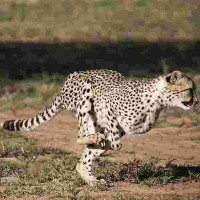 |
Cheetah |
|
He is a wild animal |
Origin |
In Africa and West Asia | |
Translation |
Francis Vandersteen |
| The possession of this animal is not authorized Royal Decree establishing the list of mammals not kept for production purposes that may be kept (M.B. 24.08.2009) |
| The cheetah is a large carnivorous mammal of the felidae family found in Africa and Western Asia. The cheetah has a slender, slender appearance, with long, slender legs with non-retractable claws, and a face with a short muzzle marked by two black marks extending from the eyes. Its coat is entirely mottled black on a very light fawn to beige background, and its young have a short mane that disappears in adulthood. It is considered the fastest land animal in the world, with a running speed of up to 115 km/h. Classified as vulnerable by the International Union for Conservation of Nature, the cheetah is currently the subject of various attempts at protection, including cloning. The species is divided into five subspecies with minor differences in morphology or behavior. Of these, the Asian cheetah and the Saharan cheetah are classified as critically endangered. The muscular, streamlined body resembles that of a greyhound: slender, almost skinny, with long, slender legs. The chest is deep and the waist narrow. The bones are light and the spine extremely flexible, enabling it to project its hind limbs far and fast. The cheetah displays a slight sexual dimorphism, with males being larger than females. Adult cheetahs measure 66 to 81 cm at the withers for females, compared with 79 to 94 cm at the withers for males, and 1.10 to 1.30 m in length for females, compared with 1.30 to 1.50 m for males, with a tail of 65 to 85 cm. Adult animals weigh from 21 to 42 kg for females and 36 to 72 kg for males, with an average of 48 kg for males and 38 kg for females. The basic color of an adult's upper parts ranges from fawn to pale beige or grayish white, with the lower parts of the coat paler, often white. The fur is dotted with round or oval black spots, from two to four centimeters in diameter. Only the white of the throat and abdomen are free of spots. The fur is thick, with slightly longer hairs on the nape of the neck than elsewhere. The last third of the tail is crowned with four to six black rings and has a thick white tuft at the tip. Its diet is carnivorous, mainly consisting of mammals weighing less than 50 kg, including several varieties of antelope, such as gazelles, springboks, peleas, impalas, lesser kudu, cob, young wildebeest and topi, steenbok, urebis, but also young warthogs and ostriches, hares, rabbits and occasionally guinea fowl. In East Africa, small Thomson's gazelles and their fawns make up 80% of its diet. This is high compared to other gazelle species living in the same region. In fact, Thomson's gazelle is more abundant in this region. In India, it hunts gazella bennettii, cervicapre antelope and axis deer. The cheetah's hunting technique differs from the stalking adopted by most big cats: to catch its prey, it approaches the herd after scanning the terrain from a tree branch, the top of a termite mound or even the roofs of cars. Once it has spotted an animal that has strayed from its group, the cheetah patiently approaches it from less than 50 meters away. It then suddenly accelerates for a few tens of seconds until it reaches its exceptional speed, enabling it to catch fast-moving animals. The cheetah hunts mainly during the day (early morning and late afternoon), when other predators are asleep, probably because it is easily intimidated by anyone who wants to steal its prey; even vultures can force a cheetah to abandon a carcass. This is why the cheetah pulls its prey to safety so it can devour it in peace. When it's full, it leaves the remains for the scavengers. Cheetahs in the Sahara mountains are an exception, as they are nocturnal hunters. When the cheetah gets close enough to its prey, it uses its paw, equipped with large, strong claws. It then crunches the prey's leg, knocking it off balance and causing it to fall. The speed of the impact is often enough to kill gazelles, otherwise the cheetah rushes to the ground and clutches the victim's throat. It executes its prey by strangulation. Once its victim is finished, however, the cheetah must wait to eat. He's exhausted from the effort he's made. During the run, his body has become dangerously overheated, and his body temperature rises to 41°C. He's also out of breath. He's also out of breath. It therefore rests for long minutes, always on the lookout, before finally devouring its prey. This explanation is disputed by a recent study. The cheetah is an efficient hunter, although its success rate varies greatly according to the type of prey, experience and sex of the hunter. Hunting gazelle fawns is successful in 76% to 100% of cases, depending on the study, while the success rate for adult animals falls from 37% to 53.5%. A sibling group of young cheetahs kills in 75% of pursuits when hunting together, while individually this rate falls to 15%. The association of adult males is no more effective, however, when hunting alone, in pairs or trios; the felines just tend to hunt larger prey. In comparison, the lion's success rate ranges from 15% to 52%. |






 English (United Kingdom)
English (United Kingdom)